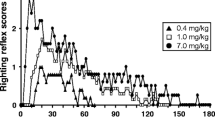Abstract
Acute morphine treatment has been shown to cause a uniform calcium depletion in various brain regions and to evoke hypermotility in mice. On the other hand, it has been reported previously that calcium channel blockers reduce the behavioral stimulation induced by different methods in mice, and it is known that these drugs increase the morphine analgesia and reduce the abstinence syndrome. The effect of calcium channel blockers, nifedipine and diltiazem, on the morphine- and amphetamine-induced hypermotility were evaluated. Mice activity was measured with photocell motility meters. The results show that neither nifedipine nor diltiazem decrease significantly the motility in control and amphetamine-treated mice; however, when they were administered to morphine-treated mice the hypermotility was significantly reduced. The mechanism responsible for this interference is still unknown.
Similar content being viewed by others
References
Baeyens JM, Esposito E, Ossowska G, Samanin R (1987) Effects of peripheral and central administration of calcium channel blockers in the naloxone-precipitated abstinence syndrome in morphine-dependent rats. Eur J Pharmacol 137:9–13
Benedek G, Szikszay M (1984) Potentiation of thermoregulatory and analgesic effects of morphine by calcium antagonists. Pharmacol Res Commun 16:1009–1018
Bolger GT, Weissman BA, Skolnick P (1985) The behavioral effects of the calcium agonist BAY K8644 in the mouse; antagonism by the calcium antagonist nifedipine. Naunyn-Schmiedeberg's Arch Pharmacol 328:370–377
Cadet JL, Taylor E, Freed WJ (1988) The iminodipropionitrile (IDPN)-induced dyskinetic syndrome in mice: antagonism by the calcium channel antagonist nifedipine. Pharmacol Biochem Behav 29:381–385
Contreras E, Tamayo L, Amigo M (1988) Calcium channel antagonists increase morphine induced analgesia and antagonize morphine tolerance. Eur J Pharmacol 148:463–466
Grebb JA (1986) Nifedipine and flunaricine block amphetamine-induced behavioral stimulation in mice. Life Sci 38:2375–2381
Grebb JA, Ellsworth KA, Freed WJ (1985) Differences between calcium channel inhibitors in their effects on phencyclidine-induced behavioral stimulation in mice. Pharmacol Biochem Behav 23:613–618
Hoffmeister F, Tettenborn D (1986) Calcium agonists and antagonists of the dihydropiridine type: antinociceptive effects, interference with opiate-receptor agonists and neuropharmacological actions in rodents. Psychopharmacology 90:299–307
Jacquet YF, Klee WA, Rice KC, Iyima I, Minamikawa J (1977) Stereospecific an nonstereospecific effects of (+) and (−)-morphine: evidence for a new class of receptors? Science 198:842
Jacquet YF, Saederup E, Squires R (1987) Non-stereospecific excitatory actions of morphine may be due to GABA A receptor blockade. Eur J Pharmacol 138:285–288
Kavaliers M (1986) Stimulatory influences of calcium channel antagonists on stress-induced opioid analgesic and locomotor activity. Brain Res 408:403–407
Kavaliers M (1987) Calcium channel blockers inhibit the antagonistic effects of Phe-Met-Arg-Phe-amide (FMRF amide) on morphine- and stress-induced analgesia in mice. Brain Res 415:380–384
Longoni R, Spina L, Dichiara G (1987) Dopaminergic D-1 receptors: essential role in morphine-induced hypermotility. Psychopharmacology 93:401–402
Middlemiss DN, Spedding M (1985) A functional correlate for the dihydropiridine binding site in rat brain. Nature 314:94–96
Ohnishi T, Saito K, Matsumoto K, Sakuda M, Inoki R (1988) Decrease in analgesic effect of nifedipine following chronic morphine administration. Eur J Pharmacol 158:173–175
Oliverio A, Castellano C (1974) Genotype-dependent sensitivity and tolerance to morphine and heroin: dissociation between opiate-induced running and analgesia in the mouse. Psychopharmacology 39:13–22
Ramkumar V, El-Fakahany EE (1988) Prolonged morphine treatment increases rat brain dihydropiridine binding sites: possible involvement in development of morphine dependence. Eur J Pharmacol 146:73–83
Ross DH, Cardenas HL (1979) Nerve cell calcium as a messenger for opiate and endorphin actions. Adv Biochem Psychopharmacol 20:301–336
Sansone M, D'Udine B, Renzi P, Vetulani J (1987) Antihistaminics enhance morphine amphetamine and scopolamine-induced hyperactivity in mice. Psychopharmacology 93:155–157
Sansone M, Castellano C, Libri V (1988) Tripelennamine enhances buprenorphine, but not pentazocine-induced hyperactivity in mice. Psychopharmacology 95:176–179
Yamamoto H, Harris RA, Loh HH, Way EL (1978) Effects of acute and chronic morphine treatments on calcium localization and binding in brain. J Pharmacol Exp Ther 205:255–264
Author information
Authors and Affiliations
Rights and permissions
About this article
Cite this article
Martin, M.I., Lizasoain, I. & Leza, J.C. Calcium channel blockers: effect on morphine-induced hypermotility. Psychopharmacology 101, 267–270 (1990). https://doi.org/10.1007/BF02244138
Revised:
Issue Date:
DOI: https://doi.org/10.1007/BF02244138




